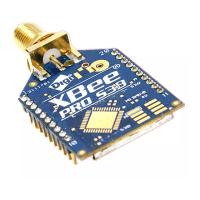XBee-PRO XSC RF Module operation Operating modes
XBee®-PRO 900HP/XSC RF Modules
200
n Returns to Idle Mode
n Send CN (Exit Command Mode) Command
For an example of programming the XBee-PRO XSC RF Module using AT Commands and descriptions
of each configurable parameter, refer to Configuration and commands.
Binary commands
Sending and receiving parameter values using binary commands is the fastest way to change
operating parameters of the module. Binary commands are used most often to sample signal
strength (RS parameter) or error counts; or to change module addresses and channels for polling
systems when a quick response is necessary. Because sending and receiving parameter values takes
place through the same data path as 'live' data (received RF payload), follow the CTS pin to distinguish
between the two types of data (commands vs 'live' data).
Common questions regarding the use of binary commands:
n What are the implications of asserting CMD while live data is being sent or received?
n After sending serial data, is there a minimum time delay before CMD can be asserted?
n Is a time delay required after CMD is de-asserted before payload data can be sent?
n How can I determine the difference between live data and data received in response to a
command?
You must assert CMD (pin 16) in order to send binary commands to the device. You can assert the CMD
pin to recognize binary commands anytime during the transmission or reception of data. The device
only check the status of the CMD signal at the end of the stop bit as the byte is shifted into the serial
port. The application does not allow control over when data is received, except by waiting for dead
time between bursts of communication.
If the device sends a command in the middle of a stream of payload data to be transmitted, the
command executes in the order it is received. If the radio is continuously receiving data, the radio
waits for a break in the received data before executing the command. The CTS signal frames the
response coming from the binary command request as shows in the following figure.
The user must observe a minimum time delay of 100 µs (after the stop bit of the command byte has
been sent) before de-asserting the CMD (pin 16). The command executes after all parameters
associated with the command have been sent. If all parameters are not received within 0.5 seconds,
the module aborts the command and returns to Idle Mode.
Note Binary commands that return only one parameter byte must also be written with two
parameter bytes, 0-padded, LSB first. Refer to for a binary programming example.
You can query commands for their current value by sending the command logically ORed (bit-wise)
with the value 0x80 (hexadecimal) with CMD asserted. When the device sends the binary value (with
no parameters), the current value of the command parameter is sent back through the DO pin.
Binary command write then read

